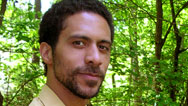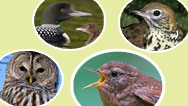Profile: Erich Jarvis
- Posted 10.18.05
- NOVA scienceNOW
(This video is no longer available for streaming.) Erich Jarvis is an unconventional, award-winning neuroscientist at Duke University whose career demonstrates the power of bringing open-mindedness into the lab. Prior to pursuing science, Jarvis studied dance and choreography at New York City's High School for the Performing Arts (made famous in the film Fame). Jarvis and his colleagues have discovered that inside a hummingbird's brain—even though that brain is very tiny—is a sophisticated neural network that allows hummingbirds to teach each other to sing. His research on the brains of birds has helped establish how a simple bird brain can solve sophisticated problems.
Transcript
Profile: Erich Jarvis
PBS air date: October 18, 2005
ROBERT KRULWICH: If you were to survey, not the universe, just the Earth, you could divide all living creatures into two groups: your smart ones and your not-so-smart ones. So on the one hand, you would have your dolphins and you would have your chimps, and we don't want to leave out your dog, or your favorite cat. On other hand we'd have, I don't know, well, moths, slugs, wheat. I mean, wheat is alive, just not all that brainy. But where on this sliding scale of smartness would you put birds?
I ask because you're about to meet a scientist who thinks birds can be much, much smarter than other scientists had supposed. And at considerable risk to his career and to his reputation, he decided to make his case. And how he did it, the way he did it, that got our attention.
Ladies and Gentlemen, may I present the winner of the 2002 Alan T. Waterman Award, The National Science Foundation's highest honor for the most outstanding young scientist or engineer in America, Dr. Erich Jarvis, as he was 25 years ago in high school.
DR. ERICH JARVIS (Duke University Medical Center): Now some of you might be saying, "Well, how do you link a scientific career to a dancer career?" You know, I can do a pirouette. Okay?
All right. I even did some African dancing. Well, I won't do that... and I do that. You want to see? Okay something like...All right. Okay.
ROBERT KRULWICH: And what he learned, training to dance, was, in a word...
ERICH JARVIS: Discipline. Um, discipline is very, very, very critical for your survival.
ROBERT KRULWICH: As it was for his. Erich didn't go to one of the city's top science-y public schools, instead he went here, where they taught him...
ERICH JARVIS: Dream big, think big, reach for the stars. Be ambitious, be bold and, uh, don't let anybody discourage you.
ROBERT KRULWICH: And by the way, you know this school...
ERICH JARVIS: The High School of Performing Arts...
ROBERT KRULWICH: Is this the one that's been in the movies? The same place?
ERICH JARVIS: Yeah, a movie called Fame.
ROBERT KRULWICH: "Oh. I want to live forever." That one?
ERICH JARVIS: That's right, that one.
CLIP FROM FAME: Fame, I'm going to live forever. I'm going to learn how to fly high! I feel it coming together...
ERICH JARVIS: And what was nice about going to a school like this...
ROBERT KRULWICH: Says Erich, is you work hard and you get choices.
ERICH JARVIS: One choice was I was offered to audition for the Alvin Ailey dance company, and, um, I also made it into the City University system, Hunter College. My personal choice was to go into science...
ROBERT KRULWICH: And the science he chose was neuroscience.
ERICH JARVIS: ...because I'm fascinated with how the brain can generate complex behaviors.
ROBERT KRULWICH: Erich and his colleagues discovered that inside a hummingbird's brain—even though that brain is very tiny and looks so primitive—is a sophisticated neural network that allows hummingbirds to teach each other to sing.
ERICH JARVIS: Song in birds is like speech in humans.
ROBERT KRULWICH: This was a breakthrough using molecular biology that Erich learned from her.
RIVKA RUDNER (HUNTER COLLEGE): Isn't that incredible? I'm the science mother.
ROBERT KRULWICH: The science mother?
RIVKA RUDNER: The science mother.
ROBERT KRULWICH: Professor Rivka Rudner adopted Erich as an undergraduate.
RIVKA RUDNER: I also, I also made a cake.
ERICH JARVIS: Oh, great.
ROBERT KRULWICH: And he spent not only days at the lab...
RIVKA RUDNER: There were times in which he would sleep over in the little office adjacent to the lab. You don't find too many kids doing it.
ROBERT KRULWICH: ...Erich contributed to six scientific papers.
RIVKA RUDNER: As an undergraduate.
ROBERT KRULWICH: So there he is in first position. And, all the while, she says, Erich brought an artist's feel to her lab.
RIVKA RUDNER: You talked about the high that you used to get when you danced. That when you had a performance...
ERICH JARVIS: Uh huh.
RIVKA RUDNER: ...you would have a real high.
ERICH JARVIS: Uh huh.
RIVKA RUDNER: Okay, and then you said, "But when I come early in the morning to the lab and open the incubator, and look at a plate and see a result to verify, let's say the cold transduction frequency, I get a high just like I used to get when I danced."
ROBERT KRULWICH: And he kept dancing. He met a girl, Miriam, whom he later married, he graduated and then his father died.
ERICH JARVIS: He was shot. So he was shot while he was sitting down. Well, they think he was sitting down, near a cave.
ROBERT KRULWICH: James Jarvis was homeless, divorced. He had been living in caves like this one that Erich visited in northern Manhattan. They never found his killers.
ERICH JARVIS: This is the richness of what represented him.
ROBERT KRULWICH: Erich's dad collected rocks and fossils and odd specimens. He was not a well man, but Erich visited him. And more than his brothers and sister, he kept that connection.
VALERIA MCCALL (Erich Jarvis's Mother): Erich has always been the mediator out of his siblings.
ROBERT KRULWICH: When times were tough, they all had to live together at the grandparents' house.
ERICH JARVIS: ...that I euphemistically called "the refugee house," because everyone who had problems in the family would live in that house. But it brought a whole bunch of cousins together, an extended family, that I basically not only had my brothers and sisters, but a whole bunch of cousins.
ROBERT KRULWICH: And from time to time he took care of most of them. This habit of partnering and supporting is fundamental to Erich, but it's not a very common way to succeed in science. Science is a "me" culture: my paper, my lab, my discovery. Erich was playing the "me" game very well, but when a problem came up that could only be solved by bringing the many "me's" together, Erich would have to choose between bettering his career or his community.
Here's the problem: this is a classic bird brain illustration by a German neurologist, Ludwig Edinger, in 1903. The names that Edinger gave to these brain parts—that have been used now for a hundred years—use Latin roots like "primitive," "ancient," not as smart as people, suggesting that birds can't learn. But if all birds have primitive brains, then how do you explain Betty the crow?
She's at Oxford University, and a few years ago, scientists put a basket of delicious meat inside this cylinder, and the question was could Betty take the wire resting there and use it fish out the meat.
Well, here's Betty and she's picking up a wire that's straight, so that's not going to work, but she's going to try. And then, jump forward a minute, she's jamming the wire against the tray wall. But look, you see, it's bent now. So she drops it in. Success!
ERICH JARVIS: I do think that this little bird is doing this with the intent to get the food.
ROBERT KRULWICH: So she's bending it, to get...?
ERICH JARVIS: Bending it to get the food. I do believe that.
ROBERT KRULWICH: So they tried 10 times more. Here, Betty is bending the straight wire by walking and pushing. And nine out of 10 times she did make a tool that worked.
HARVEY KARTEN: That's tool making!
ROBERT KRULWICH: Harvey Karten, a leader in this field thought, "Hmmmm."
HARVEY KARTEN: We hadn't normally even considered that birds were that capable.
ROBERT KRULWICH: Old Edinger, with his century-old bias that birds are stupid, apparently had it wrong. And if his labels were calling birds primitive and dumb, and then the bird goes off and plays chess, that leaves everybody, including scientists, confused.
ERICH JARVIS: I would get emails from other scientists who don't, who aren't aware of the problem. Then they email me and say, "How could hummingbirds do all this complex behavior that you described, with a brain dominated only by the primitive substance?"
ROBERT KRULWICH: Now, there aren't a lot of scientists who are passionate about this, but the group that is, really is. So as necessary as it was, changing the names was likely to get very ugly if it could happen at all. It would take someone who was collaborative by nature, and might get all of these solo characters to dance to one beat. It would take, you know who.
ERICH JARVIS: I'll do it if you guys will let me do it.
ROBERT KRULWICH: I mean that's like... that's asking for trouble.
ERICH JARVIS: I felt that it was necessary. And it was my naiveness of a young professor coming to Duke, you know? This just has to change. It was a moral thing for me to do. Changing these names wasn't easy.
ROBERT KRULWICH: First he got them together by email and it turned out...well, it was a complete mess.
"I am simply shocked," said one. "My name should not appear," says another. "I don't want to make this personal," says one of them, "but blah, blah, blah..."
And when they got together, things didn't go much better.
DR. SARAH DURAND (LaGuardia Community College): ...people running to get the dictionaries. And then the developmental neuroanatomists were supporting this viewpoint, and then the functional neuroanatomists were saying, "No, but that's peripheral to the common understanding." So we had great, great, drama. And I remember Erich kind of watching it all.
ROBERT KRULWICH: And it is exactly at this moment that Erich's lifetime of training kicks in.
HARVEY KARTEN: Erich managed to let people voice their say. He did it in a very, very intelligent way. He knew when not to talk. He knew when to listen.
ROBERT KRULWICH: When they shouted, he did this. When they stomped, he did that. They quit, he turned; they screamed, he twirled. And by the end of the conference, with Erich's leadership, they came up with new names that everyone had agreed upon.
HARVEY KARTEN: Oh, it would not have happened. I honestly don't think that it would have happened at this time without him.
ERICH JARVIS: It has been accepted. At least a hundred papers have been published since on bird brains. And I would say about 95, 98 percent of them—and I'm trying not to be too conservative here—have used the new nomenclature.
ROBERT KRULWICH: Now you might think that a triumph like this under his belt would have been a good thing for Erich, but Erich may in fact have to pay a price for his contribution.
ERICH JARVIS: I get criticized for it. I get openly criticized for being too collaborative sometimes.
ROBERT KRULWICH: Erich is at the very moment in his career when his field would have him focus on his lab work and publishing to make his name. There is less reward in science for those who have a talent for leading others.
HARVEY KARTEN: I think to some degree he gave up some of the essential things he might...we...several of us felt he should be concentrating on to get his own papers out, rather than working on this. But, you know, that's a choice he made.
ERICH JARVIS: What's most important for me is that the scientific accomplishment gets accomplished.
SARAH DURAND: He thinks broadly to see the big picture.
ROBERT KRULWICH: For Erich, this was his big picture: the gathering of scientists to improve all their work.
The photograph that I have in my mind shows you at the center of all these people. Did you orchestrate that?
ERICH JARVIS: Yes, I did. The reason for taking the photograph was to show the rest of the community, the scientific community, that we are in unison on this.
ROBERT KRULWICH: Ah.
ERICH JARVIS: Okay? And then I thought about it. I says, "Wait a minute. This is not unison enough."
ROBERT KRULWICH: So the choreographer in Erich Jarvis took over. He convinced these 28 scientists, who'd been yelling at each other for the past three days, that, for the sake of unity, for the sake of science, they needed to take one more step.
ERICH JARVIS: We hold hands, okay? And so that then even shows more our unity.
ROBERT KRULWICH: And perhaps it'll show some of the leaders in Erich's community that sometimes what even science needs is a little more art.
And a happy little postscript here: Erich Jarvis was just awarded one of the National Institute of Health's coveted Pioneer Awards—$500,000 a year to his lab for the next five years. So he took the risk and somebody noticed.
Credits
Profile: Erich Jarvis
- Edited by
- Ira Meistrich & Robe Imbriano
- Produced and Directed by
- Carla Denly & Robe Imbriano
NOVA scienceNOW
- Executive Producer
- Samuel Fine
- Executive Editor
- Robert Krulwich
- Senior Series Producer
- Vincent Liota
- Supervising Producer
- Andrea Cross
- Development Producer
- Kyla Dunn
- Associate Producer & Program Editor
- Win Rosenfeld
- Associate Producers
- Mary Robertson
Anthony Manupelli
Anna Lee Strachan - Unit Manager
- Candace White
- Production Secretary
- Ayo Babatunde
- Compositing
- Yunsik Noh
- Music
- Rob Morsberger
- NOVA scienceNOW Series Animation
- Edgeworx
- Camera
- Michael Chin
Anthony Forma
Donald Friedell
Rex Fortenberry
Mark Gunning
Scott Ransom
Edward Marritz
Daryl Patterson-Pendana
Joel Shapiro - Sound Recordists
- Sara Chin
Jeffrey Duncan
Neal Gettinger
Janice Mahan
Mark Roy
Virnado Woods - Audio Mix
- John Jenkins
- Animation
- Sputnik
- Additional Producing
- Talleah Bridges
- Production Assistants
- Robbie Gemmel
Shimona Shahi - Special Thanks
- American Indian Community House
DNA 2.0
Lassen Volcanic National Park
Tika Laudun
Louisiana Public Broadcasting
Louisiana State Wildlife and Fisheries
The Melton Family
The New York Academy of Medicine Library
33rd and Bird - Archival Material
- ABC News Video Source
BBC Motion Gallery
Getty Images
Linda Harrar Productions
Indiana State Museum and Historic Sites
Macaulay Library at the Cornell Lab of Ornithology
NASA
National Geographic Television Film Library
Prairie Pictures/Stormstock
William E. Sauro/The New York Times
WWL TV - NOVA Series Graphics
- yU + co.
- NOVA Theme Music
- Walter Werzowa
John Luker
Musikvergnuegen, Inc. - Additional NOVA Theme Music
- Ray Loring
- Post Production Online Editor
- Spencer Gentry
- Closed Captioning
- The Caption Center
- NOVA Administrator
- Dara Bourne
- Publicity
- Eileen Campion
Olivia Wong - Senior Researcher
- Barbara Moran
- Production Coordinator
- Linda Callahan
- Unit Manager
- Lola Norman-Salako
- Paralegal
- Richard Parr
- Legal Counsel
- Susan Rosen Shishko
- Post Production Assistant
- Alex Kreuter
- Associate Producers Post Production
- Nathan Gunner
Patrick Carey - Post Production Supervisor
- Regina O'Toole
- Post Production Editor
- Rebecca Nieto
- Post Production Manager
- Maureen Barden Lynch
- Supervising Producer
- Stephen Sweigart
- Producer, Special Projects
- Susanne Simpson
- Coordinating Producer
- Laurie Cahalane
- Senior Science Editor
- Evan Hadingham
- Senior Series Producer
- Melanie Wallace
- Managing Director
- Alan Ritsko
- Senior Executive Producer
- Paula S. Apsell
NOVA scienceNOW is a trademark of the WGBH Educational Foundation
This material is based upon work supported by the National Science Foundation under Grant No. 0229297. Any opinions, findings, and conclusions or recommendations expressed in this material are those of the author(s) and do not necessarily reflect the views of the National Science Foundation.
© 2005 WGBH Educational Foundation
All rights reserved
Related Links
-

Erich Jarvis: Expert Q&A
Duke University's Erich Jarvis answers questions on bird neuroscience and bird song, and he offers some career advice.
-

Bird Brains
Clues to the origins of human language are turning up in the brains of birds.
-

Name That (Bird) Tune
Match eight different songs and calls to the correct birds, and learn how they master such precise pitch and phrasing.
-

Secret Life of Mollie Woodworth
Neuroscientist Mollie Woodworth studies ways to treat brain injuries and shakes her pom-poms with MIT cheerleaders.



